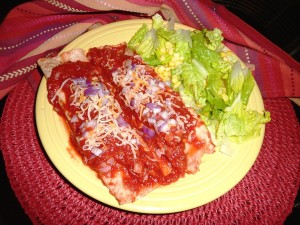Tortillas have become part of mainstream American cooking, and it’s no surprise. Whether made from flour or corn meal, they’re easy to use and are readily available.
Cooking the tomato sauce with whole jalapeño peppers gives it just a hint of hot spice. If you have a passion for hot peppers, cut them up and leave them in the sauce when it is served. If you don’t have jalapeño peppers, then just add a few drops of a hot pepper sauce.
Fred Tasker’s wine suggestion: Enchiladas with zingy jalapeños call for a wine with lots of sweet fruit; the high-acid goat cheese calls for a high-acid wine. One of the crianza-style Spanish riojas fits both bills.
Helpful Hints:
• A quick way to wash the cilantro is to immerse it in a bowl of water for several minutes while you prepare the other ingredients. Lift it out of the bowl and dirt and sand will be left behind. Shake dry and use.
• Jarlsburg or cheddar cheese can be substituted for Monterey Jack.
• Minced garlic can be found in the produce section of the market or in jars in the condiment section.
Countdown:
• Preheat oven to 400 degrees.
• Make enchiladas.
• While enchiladas are in oven, make salad.
Shopping List:
Here are the ingredients you’ll need for tonight’s Dinner in Minutes.
• To buy: 1 can reduced-sodium crushed tomatoes, 1 red onion, 2 large jalapeño peppers, 1 bag washed, ready-to-eat salad ¼ pound goat cheese, 1 bottle ground cumin, 1 bottle ground coriander 1 bunch fresh cilantro, 1 package frozen diced green bell pepper, 1 package frozen corn kernels 1 package 6-inch light flour tortillas and 1 package shredded reduced-fat Monterey Jack cheese.
• Staples: Minced garlic, reduced-fat oil and vinegar dressing, salt and black peppercorns.
Goat Cheese Enchiladas
Makes 2 servings.
Serve with the Sweet Corn Salad as a side dish (recipe below).
For the sauce:
1½ cups reduced-sodium, canned crushed tomatoes
½ cup diced red onion, plus 2 tablespoons, divided use
2 large whole jalapeño peppers
Salt and freshly ground black pepper
For the filling:
¼ pound goat cheese
2 teaspoon ground cumin
1 tablespoon ground coriander
2 teaspoons minced garlic
¼ cup chopped fresh cilantro
1 cup frozen diced green bell pepper
4 6-inch light flour tortillas
2 tablespoons shredded reduced-fat Monterey Jack cheese
Preheat oven to 400 degrees. Line a baking tray with foil.
Make the sauce: Place crushed tomatoes, ½ cup onion and whole jalapeño peppers in a medium-size saucepan and bring to a boil. Reduce heat and simmer gently, uncovered, for 10 minutes. Add salt and pepper to taste.
Make the filling: Mix goat cheese, cumin, coriander, garlic, cilantro and green bell pepper together in a bowl. Divide into 4 portions. Dip the tortillas, one at a time, into the tomato sauce. Make sure they are completely covered with sauce. Remove to the baking tray and spoon one quarter of the filling into the center of each tortilla. Roll up. Spoon half the remaining sauce over the top and cover with foil. Place in the oven for 10 minutes. To serve, remove jalapeño peppers from sauce left in the pan. Place 2 enchiladas on each plate and spoon remaining sauce over the top. Sprinkle with grated cheese and remaining 2 tablespoons onions.
Per serving: 466 calories (45 percent from fat), 23.3 g fat (13.8 g saturated, 6.6 g monounsaturated), 49 mg cholesterol, 25.3 g protein, 49.2 g carbohydrates, 16.2 g fiber, 824 mg sodium.
Sweet Corn Salad
Makes 2 servings.
1 cup frozen corn kernels
4 cups washed, ready-to-eat salad
2 tablespoons reduced-fat oil and vinegar dressing
Defrost corn by placing it in a colander and running hot water through it or microwave on high 2 minutes. Add to the salad and toss with the dressing.
Per serving: 87 calories (18 percent from fat), 1.8 g fat (0.2 g saturated, 0.5 g monounsaturated), 1 mg cholesterol, 3.3 g protein, 17.9 g carbohydrates, 3.5 g fiber, 14 mg sodium.
